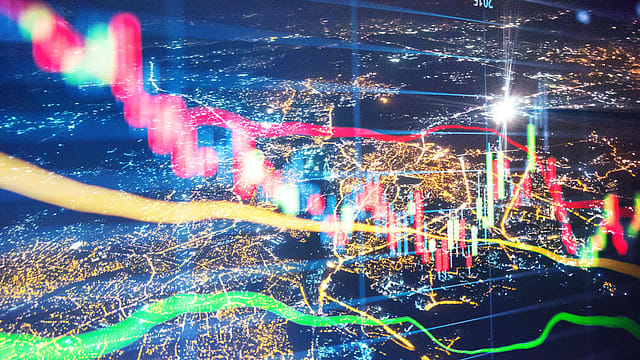Will U.S. Fed-induced rate hike push the world into recession?
ADVERTISEMENT

Whether it is riskier assets such as equities and cryptocurrencies or safe-haven assets like gold and treasury yield, the U.S. Federal Reserve's aggressive rate hike has rattled all investment avenues alike. The inflation-led rate hike has taken a toll on global economic growth as central banks across the globe have responded to the rising costs by rounds of extensive monetary tightening, which many agencies fear that economies may slip into recession in the near term. A number of investment banks have raised the alarm over the risk of a recession, including JP Morgan, Golman Sachs, Wells Fargo, Deutsche Bank and Morgan Stanley.
The U.S. Federal Reserve has delivered back-to-back interest rate hikes for the first time in two decades to rein in inflation, which remained at a 40-year high. The Federal Open Market Committee (FOMC) on Wednesday raised official interest rates by three-quarters of a percentage point to 1.75%, its biggest hike since 1994, to combat rising prices caused by the Russia-Ukraine conflict and global supply chain disruption amid the Covid-related lockdowns in China. The U.S. central bank in its policy statement also projected a slowing economy and rising unemployment in the months to come due to interest rate hikes. It released a statement which estimates rates to go up to 3.4% by the end of the year and 3.8% next year.
Given that inflation is likely to remain elevated in the coming months, thanks to the ongoing Russia-Ukraine war and an uptrend in commodity prices, especially crude oil, there are high prospects that the Fed and other central banks may continue their hawkish policy stance to combat rising costs.
December 2025
The annual Fortune 500 India list, the definitive compendium of corporate performance, is out. This year, the cumulative revenue of the Fortune 500 India companies has breached $2 trillion for the first time. Plus, find out which are the Best B-schools in India.
However, some analysts do not see the global economy slipping into recession and think that a well-communicated monetary normalisation strategy would avert a hard landing of the economy. Dhananjay Sinha, MD and chief economist at JM Financial Institutional Securities, says that the Federal Reserve has adopted a restrictive path toward increasing the real rate above the neutral rate of 0.5% to curb inflation. “The Fed’s desirable path expects a series of declines in headline inflation before easing the tightening path. And since the Fed does not want to be behind the curve, the possibility of upside surprises in inflation numbers in the near term could imply front loading another 75 bps in the next one in July,” says Sinha.
He further states that the inherent strength of the U.S. economy will ensure that the country will avoid a hard landing of the economy or a recession, thereby engendering a base case of a soft landing. “Thus, while real GDP growth is expected to decelerate sharply from 5.7% in 2021 to 1.7% in 2022 versus 2.8% as per previous projection, and remain at 1.7% in FY23, it is likely to remain around the long-term potential growth of 1.8,” he added.
On the Fed’s projection for economic growth and unemployment, he said that even with the 100 bps and 50 bps lower real GDP growth estimates, unemployment rates at 3.7% in 2022 and 3.9% in 2023 are likely to remain below the long-term non-inflationary levels of 4%. Thus, the labour market is expected to remain robust despite the sharp deceleration in real GDP growth, Sinha said.
“The Fed’s confidence to avoid a recession even with the induced tightening of financial conditions comes from the perception that a) the US economy is inherently strong, especially on the demand side, and b) a fairly strong labour market. The attempt is to get back to the pre-pandemic healthy labour market condition, as against the current adverse labour demand-supply mismatch that is inimical for price stability objectives,” the economist added.
Suman Bannerjee, CIO at Hedonova, a U.S.-based Hedge fund, was expecting a 1% rate hike, instead of 0.75%, citing the quantum of money printed in the Covid era and high inflation.” The Fed is currently playing catch up. The economy has been flying high on stimulus money now it's time to take the punch bowl away. There is more than enough liquidity in the system to absorb a couple of hundred basis points in rate hikes. A high inflationary environment for an extended time will have severe negative effects on global trade too.”
Ramkumar Venkatramani, lead, Investment Advisory at private wealth management platform Kristal.AI, says the current spike in inflation, though initially driven by supply crunches, has become stickier and is sustained by a strong job market and further exacerbated by the war in Europe. “This spike in inflation in the U.S. and in Europe is forcing the central banks including the US Fed to eye a sharp increase in interest. The anticipation of aggressive Fed action has spooked markets across the world including Asia."
Venkatramani says that the increase in U.S. rates would make it more attractive for yield seeking investors at the expense of emerging markets. More importantly, if the Fed’s aggressive action led to a recession in the U.S., it can quickly spread to other parts of the world, slowing down the global growth rates, he adds.
India also faces economic distress as the Omicron and Ukraine war impacted growth in the first half of 2022, while rising inflation propelled the Reserve Bank to hike rates by 0.9% in the last two months. Given that the headline CPI inflation seen above RBI’s upper threshold limit of 6% in the coming months, the central bank is likely to raise policy rates in the latter part of the year. Global rating agencies expect the RBI to increase policy rate by another 100 basis points to 5.9% by December 2022.
